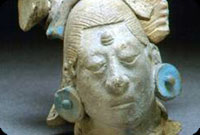Archaeology announces top 2008 finds
The Archaeology magazine has announced the top 10 finds of 2008, describing the past year as that of imperial Roman marble heads.
Archaeology’s top 10 for 2008:
The secret of Maya Blue: Scientists found that the sacred blue pigment Mayans used in religious ceremonies, was made through the ritual burning of a mixture, including indigo, minerals and copal incense.
Masked mummy of Peru: An intact 1,700-year-old mummy, was unearthed in Lima, bearing a wooden mask with seashell eyes. Archaeologists say it belongs to a master weaver from Peru’s Wari culture.
bearing a wooden mask with seashell eyes. Archaeologists say it belongs to a master weaver from Peru’s Wari culture.
The stone with soul: A 2,800-year-old basalt tomb was found in Turkey. An inscription hewed into it showed that the Iron Age culture believed the soul was separate from the body and could inhabit a monument.
Brown gold from Oregon: Preserved feces found in an eastern Oregon cave showed that the colonization of the Americas by humans dates back to 14,300 years ago. DNA studies provided more information about the ancient inhabitants of the Americas.
Oldest oil paintings: The world’s oldest-known paintings were found in a maze of caves in Afghanistan’s Bamiyan Valley.
The first European? A 1.3 million-year-old chunk of a human jawbone was unearthed in a cave in northern Spain. The find showed that early humans entered Europe about 500,000 years earlier than previously thought.
The earliest shoes: 42,000-year-old human toe bones found in China showed that the person wore some form of footwear.
Pristine Portuguese shipwreck: A 16th-century cargo ship found buried on the seafloor off the coast of Namibia.  The find included almost 50 pounds of gold coins, navigational instrument and elephant tusks among other treasures.
The find included almost 50 pounds of gold coins, navigational instrument and elephant tusks among other treasures.
The colossal heads of the Roman Empire: Parts of statues depicting Roman emperor Marcus Aurelius and Faustina the Elder (wife of the emperor Antoninus Pius) were found in central
Turkey.
The origins of whaling: A 3,000-year-old 20-inch-long walrus tusk was found on Russia’s Chukotka Peninsula, which bears the carvings of a seal, a bear and a boatful of people
hunting a whale. Archeologists believe it is the earliest evidence of whaling.